Mega Projects: The Largest Construction Endeavors Ever Undertaken
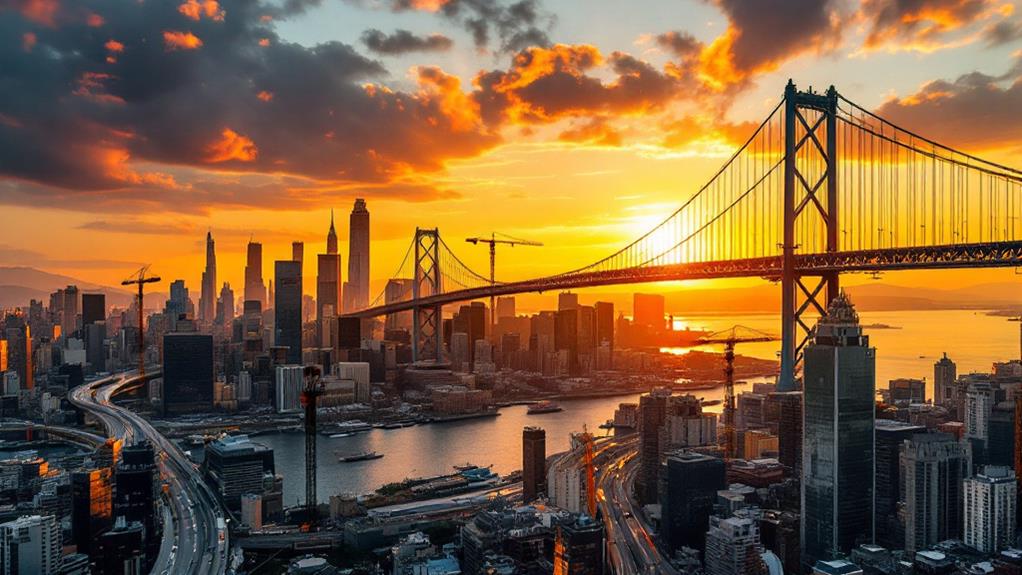
You're stepping into the domain of mega projects, where imagination meets reality on a grand scale. Picture NEOM City in Saudi Arabia, a $500 billion marvel redefining sustainability with its linear design. Consider the global connectivity through the $250 billion Gulf Railway Project. Get a glimpse of future energy from Africa's largest hydroelectric plant, the Grand Ethiopian Renaissance Dam. Meanwhile, the International Space Station embodies a $150 billion leap in human collaboration in space. These projects showcase the epitome of engineering, ambition, and innovation. Each represents a story of human achievement waiting to captivate you with further details.
NEOM and The Line
In the domain of visionary urban planning, NEOM and The Line in Saudi Arabia stand out as extraordinary examples of what future cities could look like. NEOM City, a pioneering initiative led by Crown Prince Mohammed bin Salman, is a demonstration of the ambitious goals set forth in the Saudi Vision 2030 plan. With a staggering investment of $500 billion, primarily funded by the Public Investment Fund, this project is designed to propel economic transformation and set new standards in urban living.
At the heart of NEOM City lies The Line, a groundbreaking linear city stretching 170 kilometers. It's designed with sustainability at its core, featuring zero carbon emissions and a complete absence of cars. By integrating nature into its urban environment, The Line aims to redefine how you experience city life. This future-oriented community attracts global talent and innovation by focusing on advanced, inventive technologies that prioritize environmental sustainability.
NEOM City's vision reimagines urban living by offering a model for future cities. It emphasizes a high quality of life within a sustainable framework, aligning perfectly with the broader goals of Saudi Vision 2030 to diversify the economy and promote pioneering infrastructure projects.
Transformative Transportation Projects
Imagine a world where traveling between cities is faster, smoother, and more environmentally friendly. With transformative transportation projects underway, this vision is becoming a reality. These projects are reshaping global connectivity, enhancing public transport accessibility, and demanding substantial investment. Here's a glimpse into some of the most ambitious endeavors:
- Gulf Railway: Spanning over 2,000 kilometers, this $250 billion project aims to unite Bahrain, Kuwait, Oman, Qatar, Saudi Arabia, and the UAE, enhancing regional connectivity like never before.
- California High-Speed Rail: At an estimated cost of $80 billion, this project plans to link major Californian cities with 800 miles of high-speed track, drastically cutting travel times and improving access.
- Crossrail (Elizabeth Line): This $22 billion venture will expand central London's network capacity by 10%, connecting the east and west through a new railway line, making daily commutes smoother.
- Grand Paris Express: With a $41 billion investment, this expansion will add 200 kilometers of tracks and stations, greatly improving public transport accessibility across the Paris metropolitan area.
The Melbourne Metro Tunnel also deserves mention, as its $7 billion twin tunnels are expected to raise network capacity by 45%, reducing congestion in Melbourne's heart. These projects are game-changers in modern transportation.
Pioneering Renewable Energy Initiatives
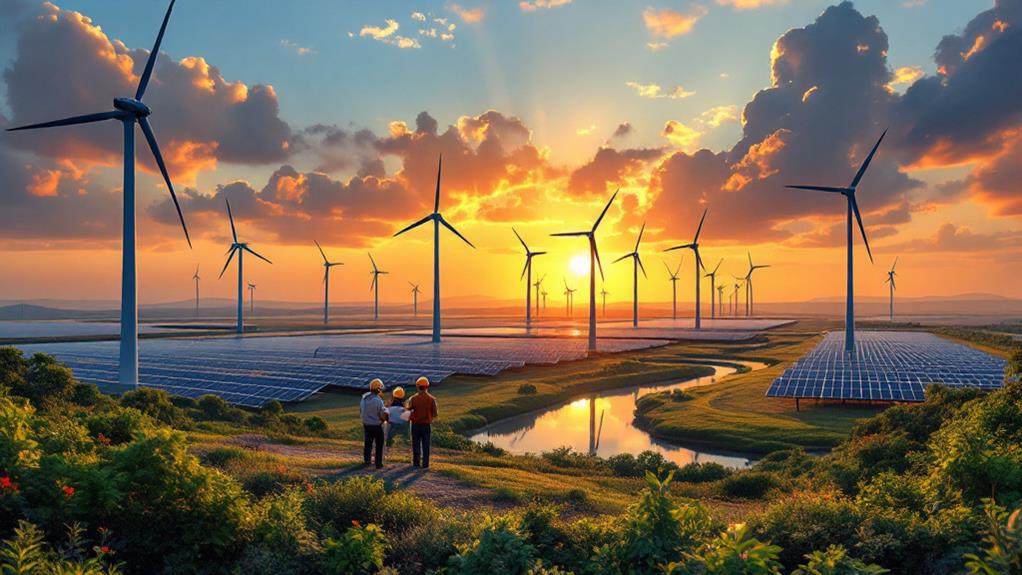
Renewable energy initiatives often redefine how we think about power generation in our modern world. The Grand Ethiopian Renaissance Dam, with its massive $4.8 billion investment, stands as Africa's largest hydroelectric power plant. Once complete, it will generate 6,450 MW of electricity, fueling economic growth and job creation across the region. Likewise, the Dholera Solar Power Plant in Gujarat, India, is part of the push for solar power plants, with its $169 million project set to deliver 700 MW of clean energy. Covering 11 square kilometers, this initiative contributes considerably to sustainable energy production.
In Canada, the LNG Canada Project showcases a commitment to reducing carbon footprints, boasting a budget of $40 billion. It aims to become the world's most carbon-efficient liquefied natural gas facility, setting a benchmark for future renewable energy initiatives. Meanwhile, the Hinkley Point C Nuclear Power Station in the UK, expected to supply around 7% of the UK's electricity, is crucial in phasing out coal by 2024.
These projects highlight how renewable energy initiatives not only transform power generation but also drive economic growth, job creation, and sustainable energy futures, paralleling global infrastructure undertakings like Maktoum International Airport.
Airport and Aviation Milestones
Just as renewable energy projects redefine power generation, monumental airport and aviation developments reshape global connectivity. These mega projects not only improve capacity but also revolutionize aviation infrastructure around the world. Here's a snapshot of some of the most crucial milestones:
- Al Maktoum International Airport: With a staggering construction cost of $33 billion, this Dubai marvel aims to handle 255 million passengers annually by 2050, making it one of the largest airports globally.
- New Istanbul Airport: Opened in 2018, this $12 billion project boasts six runways and the largest single-roof terminal on the planet. It's designed to accommodate 200 million passengers each year, markedly increasing Turkey's aviation capacity.
- Changi Airport Terminal 5: Singapore's upcoming expansion, estimated at $9 billion, is set to raise the airport's capacity to over 135 million passengers annually, cementing its status as a leading aviation hub.
- Beijing Daxing International Airport: With its distinctive star-shaped design, this $11 billion airport, opened in 2019, aims to serve 100 million passengers annually, elevating China's aviation infrastructure.
These projects, along with Heathrow Airport's $17 billion expansion, are crucial in shaping the future of global air travel.
Ambitious Urban Developments
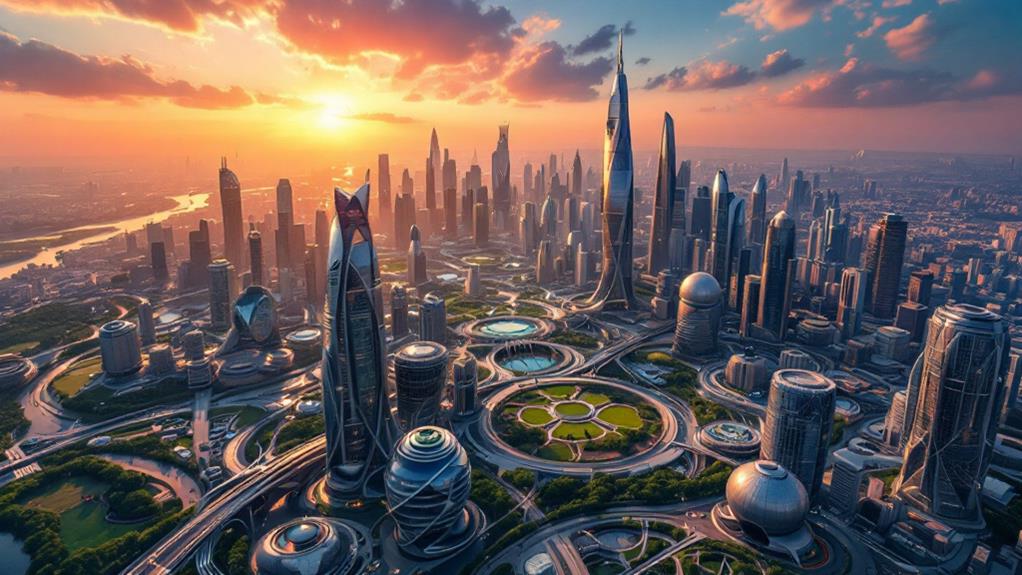
In the domain of ambitious urban developments, cities like NEOM in Saudi Arabia are pushing the boundaries of what modern living can be. NEOM City, part of Saudi Vision 2030, boasts a staggering $500 billion budget, aiming to redefine urban living through sustainable urban practices. One of its most groundbreaking components, The Line, is a 170-kilometer linear city designed without cars. It promises zero carbon emissions and merges nature seamlessly into everyday life, reflecting cutting-edge urban planning.
Another remarkable project is the King Abdullah Economic City, also in Saudi Arabia. With a total project cost of $100 billion, it's designed to accommodate nearly two million residents. This ambitious project focuses on enhancing economic growth and urban development in the region. Meanwhile, Dubailand in Dubai, spanning 107 square miles, is set to become a major tourism and entertainment hub, with a total project cost of $64.3 billion, offering numerous visitor attractions.
The New Capital Mega Project in Egypt further exemplifies ambitious urban planning. With a $45 billion budget, it aims to establish a new administrative capital featuring over 1,000 mosques and 40,000 hotel rooms, representing a bold step in urban development.
Space Exploration Ventures
Amidst humanity's quest for knowledge beyond our planet, the International Space Station (ISS) stands as a monumental feat of engineering and international collaboration. With an estimated total cost of $150 billion, the ISS serves as a vital microgravity research laboratory in low Earth orbit. Here, astronauts engage in scientific research that benefits life on Earth and supports space exploration's future. The ISS has orbited Earth continuously since November 2000, at an astonishing speed of 17,500 miles per hour, fostering international collaboration among NASA, ESA, JAXA, CSA, and Roscosmos.
The expansion of the ISS, estimated at $100 billion, promises to further improve its capabilities. This ambitious project includes the incorporation of new modules and technologies aimed at supporting a long-term human presence in space. As a result, the ISS will be a fundamental stepping stone for future missions to the Moon and Mars.
Here's why the ISS expansion matters to you:
- Boosts scientific research: More advanced experiments and breakthroughs.
- Strengthens international collaboration: Fosters global partnerships.
- Supports long-term space exploration: Prepares for Moon and Mars missions.
- Inspires future astronauts: Encourages new generations to reach for the stars.
China's Massive Infrastructure Projects
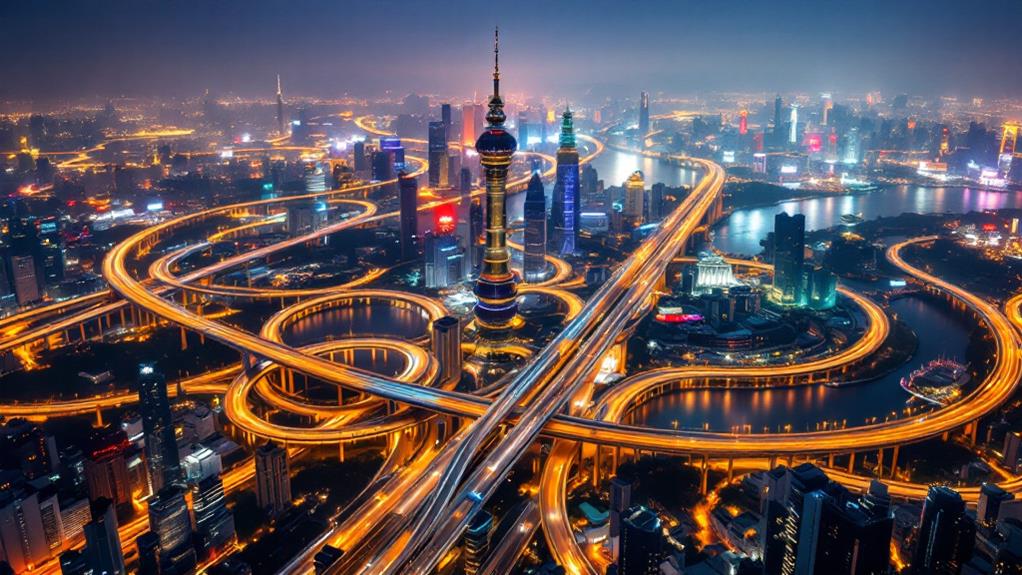
While the International Space Station represents humanity's strides in space, China's colossal infrastructure projects showcase our ability to reshape the Earth itself. You're witnessing development projects on an unprecedented scale, including the world's largest water diversion project. The South-North Water Transfer Project, costing $62 billion, aims to channel 44.8 billion cubic meters of water annually from the Yangtze River to northern China by 2050. Engineering and construction marvels don't stop there.
The Beijing Daxing International Airport, completed in 2019 at a cost of $11 billion, is designed to handle 100 million passengers annually, making it one of the largest airport projects worldwide. Meanwhile, the Hong Kong-Zhuhai-Macau Bridge, an $18.8 billion venture, features the longest bridge-tunnel sea crossing system globally, stretching 55 kilometers.
Adding to the skyline, the Shanghai Tower stands tall at 632 meters as the second-tallest building in the world, with a construction cost of $2.4 billion, highlighting advanced engineering and sustainable design.
The Chinese Belt and Road Initiative, with its $1 trillion price tag, reflects China's ambitious infrastructure strategy, impacting urban developments across Asia, Europe, and Africa, all powered by cutting-edge geospatial technology.
Engineering Marvels Across the Globe
Beyond the boundaries of imagination, engineering marvels across the globe showcase humanity's relentless pursuit of innovation and progress. These construction endeavors push the limits of technology and architecture, offering solutions to global challenges.
- NEOM City: Imagine a sustainable city stretching 170 kilometers across the Saudi desert. Part of the Vision 2030 plan, this $500 billion project aims to redefine urban living with The Line, a car-free linear city that prioritizes green spaces and renewable energy.
- Grand Ethiopian Renaissance Dam: This $4.8 billion hydroelectric power plant is set to become Africa's largest, boasting a capacity of 6,450 MW. It promises to transform the region's energy landscape by providing a sustainable power source.
- Gulf Railway Project: Spanning over 2,000 kilometers, this $250 billion project connects six Gulf Cooperation Council (GCC) countries. It improves regional transportation and trade, creating an essential link across the Arabian Peninsula.
- Hong Kong-Zhuhai-Macau Bridge: This remarkable $18.8 billion structure is the longest bridge-tunnel sea crossing worldwide. By connecting three major cities, it considerably reduces travel time and exemplifies astounding engineering prowess.
The Large Hadron Collider in Switzerland, another feat, explores the mysteries of particle physics, marking it as an iconic engineering marvel of our time.
Economic Growth Through Construction
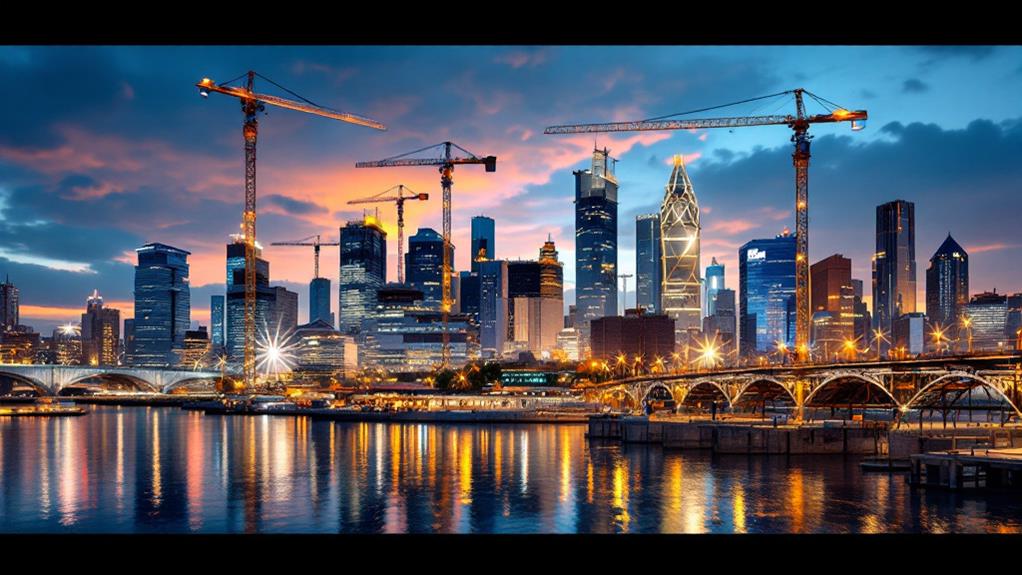
Through ambitious mega projects, economic growth finds a powerful ally in the construction industry. These massive endeavors, like NEOM City in Saudi Arabia, aim to diversify economies and foster sustainable growth. With a staggering $500 billion investment, NEOM promises to transform regional urban environments and stimulate job creation. Likewise, the Gulf Railway project, costing $250 billion, focuses on enhancing trade integration by connecting multiple Gulf nations, thereby improving economic connectivity.
Infrastructure investments also play an essential role in stimulating local economies. Take the $80 billion California High-Speed Rail, for instance. It's not just about faster travel; it's about increasing connectivity between major cities and creating thousands of jobs. The Grand Paris Express expansion is another example. With a cost of approximately €35 billion, it's set to increase public transport capacity by 10%, facilitating more economic activity in urban areas.
Furthermore, projects like Dubailand in Dubai highlight the potential of mega projects to elevate tourism and open new economic opportunities. With a $64.3 billion price tag, Dubailand is designed to draw tourists and foster growth in rapidly expanding urban environments, ultimately propelling economic growth.



